Spider Lily (Crinum asiaticum) Uses, Research, Remedies, Medicines
Nagadamani- Crinum asiaticum is an Ayurvedic herb used for the treatment of snake bite, fever, joint pain, skin diseases and leucorrhea.
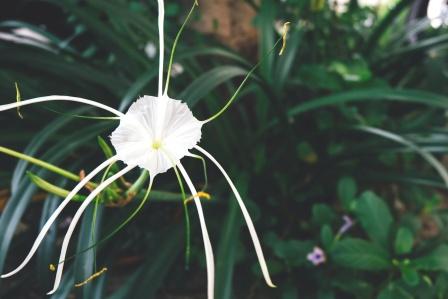
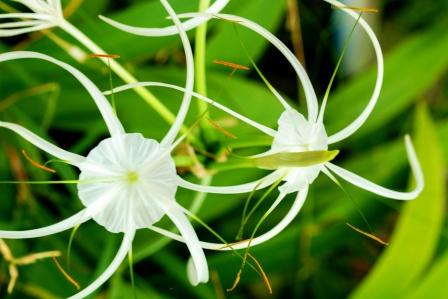
Latin name- Crinum asiaticum Linn., Crinum latifolium
Family- Amaryllidaceae
Table of Contents
Vernacular names
Names in different languages:
Hindi name- Shukadarshana, Chindar, Pindar, Badakanvar
English name- Poison bulb, Spider Lily, Cape Lily Flowers, Crinum lily
Arabic name -Haliyaon
Bengali name -Sookhdursun, Bara Kanur
Guajarati name-Nagdowan / Nagadamani
Konkani name-Kartmari
Malayalam name-Visamoolam
Marathi name- Nagadavana
Tamil name- Vishamungil
Telugu name -Kesar chettu, Lakshminarayana chettu
Arabic name – Haliyaon
Konkani name – Kartmari
Persian name – Marchobia
Sinhalese name – Tobalo
Chinese name – Ouen chou lan
Burmese name – Koyangi
Ceylon name – Vishamungil
Lakhimpur name – Kaneripat
Cohin China name – Mansylan
Morphology
Morphology of Crinum asiaticum:
It is a small perennial shrub growing to a height of 2-3 m. The leaves of the plant are 90-100 cm long and 9-10 cm wide and appear as if sprouting from the base or ground. The flowers are white in color and emerge from the middle of the trunk and are seen from the month of April- August. The fruits are little round in shape.
Properties, part used, dosage
Medicinal properties of Spider Lily:
Rasa (Taste) – Madhura (Sweet), Tikta (Bitter)
Guna (Qualities) –Ruksha (Dry in nature), Teekshna (Strong)
Vipaka – Madhura (Undergoes sweet taste after digestion)
Veerya (Potency) – Ushna (Hot)
Karma (Actions) – Pitta Kapha shamaka (reduces vitiated Pitta and Kapha)
Part used- Rhizome, Leaf
Dosage-
Rhizome powder- 1 to 3 g
Decoction- 5 to 10 ml
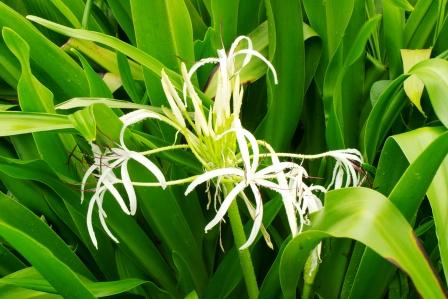
Chemical composition
Chemical composition of Crinum asiaticum:
The rhizome of the plant contains latifine, crinamine, powellins, crinine, glucans A & B, crinifoline and crinafolidine. Bulb contains alkaloid hippeastrine. The leaves contain alkaloids latifine and cherylline.
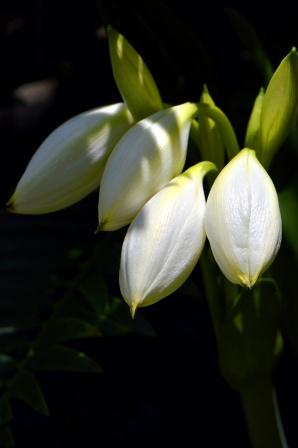
Uses, Sanskrit verse
Uses of Nagadamani:
- Juice extracted from slightly heated leaves are used as ear drops to treat earache and inflammation of the external ear.
- Grated coconut is mixed with fried powder of the rhizome of Nagadamani and mustard oil and applied over the joints having pain and inflammation.
- The paste of the leaves of Crinum asiaticum is fried in castor oil and applied over the fingers having nail bud infection and inflammation.
- The rhizome powder or decoction of Crinum asiaticum is given orally or used as nasal drops to induce emesis in cases of poisoning due to snake bite or plant poisoning.
- The seed of Chakramarda (Cassia tora) is mixed with rhizome of Nagadamani and made into paste and this is applied over the area affected with skin diseases.
- Juice of the leaves after they have been slightly roasted is a popular remedy for earache.
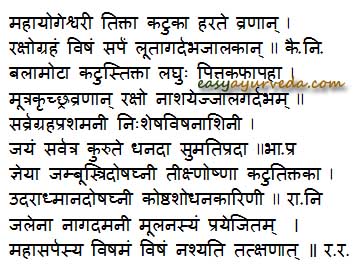
Uses as per Ayurveda:
Koshta Shodhana – cleanses and detoxifies stomach and intestines
Teekshna – strong, piercing
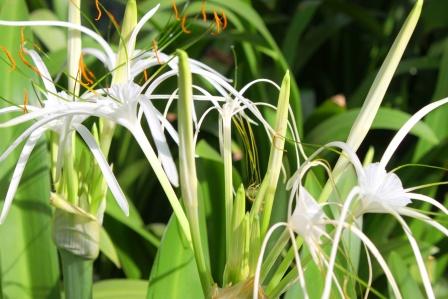
Indications
Indicated in –
Vrana – Ulcers, wounds
Rakshograha – useful in psychiatric disorders
Visha – Toxic conditions, poisoning
Sarpa – snake bite
Luta – insect bite
Mutrakrichra –Dysuria, urinary retention
Jalagardabha – skin disease
Graharoga – Psychiatric disorders
Udara – ascites, enlargement of the abdomen
Adhmana – bloating, gaseous distension of abdomen
Pharmacology
It is emetic, diaphoretic, purgative, laxative, carminative, antipyretic, anthelmintic, useful is biliousness, strangury, snake bite, vomiting, urinary discharges, tumours, diseases of the vagina, the abdomen, the blood, diuretic.
Root is made into juice extract. It is used as nasal drops for snake bite poisoning.
Therapeutic uses
Sarpavisha – Nagadamanimula is squeezed to extract the juice which is used as nasal drops.
Pradara – Leucorrhea – Fine paste of the root of Sudarshana taken with milk.
Kushta (skin disease) – Chakramarda seed and jeeraka in equal parts with a little of sudarshana destroy ringworm and kushta.
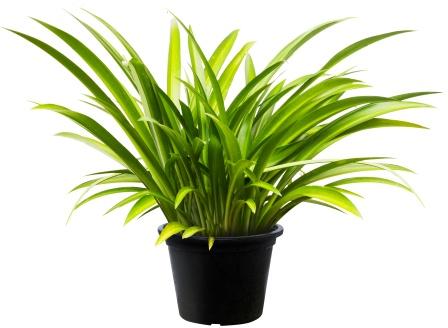
Adverse effects
The sap of the plant may cause skin irritation if it is put over the skin. The rhizomes can cause gastric irritation, colic pain of abdomen, nausea. Hence the plant should be used with proper care.
Interaction with medicines, supplements
Can this be used while taking Homeopathic medicine?
Yes. This product does not react with homeopathic medicine.
Can
this medicine be continued while taking supplements like multivitamin tablets,
Omega 3 fatty acids etc?
Yes. Generally, this product goes well with most
of the dietary supplements. However, if you are taking more than one product
per day, please consult your doctor for an opinion.
With western
medicines
Seek your
doctor’s advice if you are taking this product along with other western
(allopathic / modern) medicines. Some Ayurvedic herbs can interact with modern
medicine.
If both Ayurvedic and allopathic medicines are advised together, then it is
best to take Allopathic medicine first, wait for 30 minutes and then take the
Ayurvedic medicine.
Research
Research articles related to Crinum asiaticum:
Anti- inflammatory action: The methanol extract of Crinum asiaticum bulb was evaluated for its anti-nociceptive properties on the pain induced by acetic acid and formalin in Swiss albino mice. Oral administration of bulb extract at a dose of 1.5g/kg & 2g/kg showed the highest inhibition 52.56% and 47.37%, respectively, at the 3rd hour of administration whereas at a dose of 1g/kg showed 37.5%inhibition at the 4th hour.

Anti- bacterial activity: Aqueous and ethanol extracts from the leaves of crinum asiaticum plants were investigated for their antibacterial activity against gram negative bacteria Pseudomonas aeruginosa (ATCC10031) Klebsilla pneumoniae (ATCC 10031) and Escherichia coli (ATCC 25922) and gram positive bacteria Staphylococcus aureus (ATCC 11632) and Bacillus subtilis (ATCC 23859) using the agar well diffusion, disc diffusion and broth dilution methods. We conclude that the leaf of Crinum asiaticum is a natural source of new antibacterial compounds.
Classical categorization
Bhavaprakasha- Guduchyadi varga
Kaiyyadeva Nighantu- Oushadhi varga
Raja Nighantu- Parpatadi varga
Sanskrit synonyms
Sanskrit Synonyms of Nagadamani:
Nagapushpi- Flower resembles to that of hood of snake
Nagapatra- The leaves resemble that of hood of snake
Vishapaha – useful in poisoning
Madaghni – useful in intoxication
Balamota, Nagadanti, Ishwari, Maha Yogeshwari,
Luta Gardabha Ghatini, Rasna, Durgharsha, Dussaha
Vruttapushpa – globulus, spherical flower
Sarvagrahapaha – useful in astrological treatment
Word derivation:
Nagadamani – Nagodamyathe anayethi
Nagapushpi – Nagasya nagakesarasya pushpamiva
Nagapatra – Nagadamanam patra yasya
Vishapaha – Visham apahanthi ithi
Balamota – Balamotayathi ithi
Nagapatri – Nagavath pathra yasya
Rasna – Rasyathe ithi
Nagadanti – Nagasya gajasya danta eva phaladyakare yasya
Yogeshwari – Bandya karkotaki ithi
Ishwari – Ishte ithi
Habitat
It grows at hot climate & along the sea coasts
Author: Dr.B.K.Prashanth M.D (Ayu), Ph.D
E mail: [email protected]
Click to consult Dr Prashanth BK











2 comments
Kara
Maybe there is a mistake?
“Karma (Actions) – Kapha vata shamaka (reduces vitiated vata and pitta dosha).”
Dr J V Hebbar MD(Ayu)Author
Thanks for pointing out. We corrected it now. Bhavaprakasha has mentioned – Pittakaphapaha – Balances Pitta and Kapha Dosha.